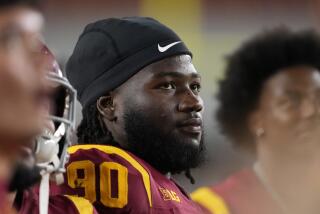The Doors to Women’s Locker Rooms Slam Shut on Sportswriters
This week, Annika Sorenstam will become the first woman in 58 years to compete in the men’s PGA Tour when she tees off at the Colonial. Her appearance, though, isn’t the only crossover event involving women in recent months: A woman coached a major college men’s basketball team for the first time when Teresa Phillips took over at Tennessee State, if only for a game. And golfer Suzy Whaley qualified for the Greater Hartford Open in July.
Yet, despite these dramatic turns, there is one area that remains largely out of bounds to me and my colleagues of both sexes: the women’s locker room. I cannot interview most women athletes in their lair, even though women sportswriters were let into the locker rooms of male athletes a long time ago.
Two notable women’s sports exceptions are the WNBA, which allows invasions by writers of both sexes before and after basketball games, and the WUSA, the soccer league. The U.S. Open is the only event on the tennis tour that allows men into women’s locker rooms. On the women’s golf tour, only its Open championship allows men and women to enter even an area adjacent to the locker room.
What’s the big deal about not being able to get into all women’s locker rooms? In my 40-plus years of interviewing athletes, the most candid exchanges took place in a locker room milieu. The reader has benefited from that access. Among what I would have missed:
There was the moment Joe Namath threw a game-losing interception and then wailed in the locker room, “I stink.”
And there was the time I interviewed the midget wrestler Sky Lo-Lo in Madison Square Garden and commented on the remarkable recovery powers of pro wrestlers. “Are you implying it’s fixed?” he said with a snarl. “We’re honest.”
In locker rooms I have seen hockey goalies throw up; I have seen a team president, quite drunk, deliver a between-periods lecture to his troops; have seen Walt Frazier anoint the future Sen. Bill Bradley as “Dollar Bill” after his Knicks’ debut; have seen the late Yankees manager Billy Martin stash his empty wine bottle in the trash basket under his desk. I have never seen a moment like this in women’s sports because, for the most part, I’m not permitted to.
Isn’t it important to write about the moments that women athletes must go through, too? I would have loved to have been there behind the scenes when Tonya Harding and Nancy Kerrigan faced off in the 1994 Winter Olympics after Kerrigan was kneecapped by a Harding factotum.
By not being permitted in the locker room, our perceptions are limited. For better or worse, readers expect inside gossip, insights gained away from the playing field -- information they have not received from channels 2 to 96.
I decry the injustice -- especially because I played a role in getting women writers into the building. I helped break in a Princeton graduate named Robin Herman when she became the New York Times’ first full-time female sportswriter 30 years ago. Herman had to interview athletes in the hallway. I also was in Washington 30 years ago writing about the advent of Title IX and its beautiful premise of equal access.
Equal access has not usually been the case for me and my colleagues since the rise of women’s sports, though. We wait outside. When jockey Julie Krone (the only female rider at Aqueduct then) came out of her private locker room, I interviewed her in the hallway. At a recent basketball game at St. John’s, where top-ranked Connecticut played, we interviewed players in a media room. There, with the coach sitting nearby, the women gave us platitudes.
Do I really need to be in a women’s locker room? That isn’t the question. It’s one of equal access, isn’t it? I wouldn’t want to make a federal case out of it.
I’m glad Annika Sorenstam didn’t have to sue anybody to get on the course. She earned it.
Gerald Eskenazi covered sports for the New York Times for 41 years before retiring in 2000. His autobiography, to be published next year, is entitled “Blood, Sweat and Cheers.”
More to Read
Go beyond the scoreboard
Get the latest on L.A.'s teams in the daily Sports Report newsletter.
You may occasionally receive promotional content from the Los Angeles Times.










